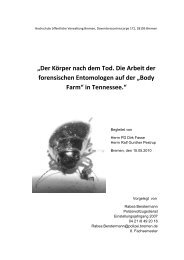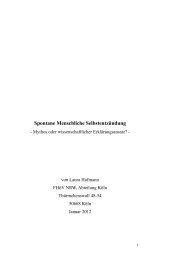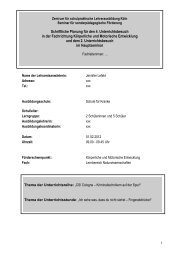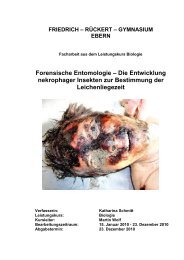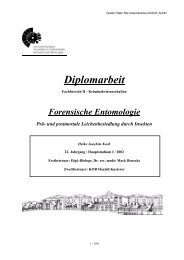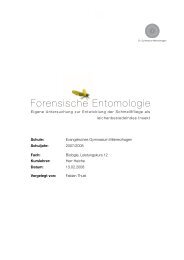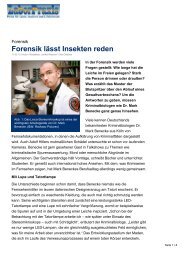A brief survey of the history of forensic entomology - Wiki2.benecke ...
A brief survey of the history of forensic entomology - Wiki2.benecke ...
A brief survey of the history of forensic entomology - Wiki2.benecke ...
Create successful ePaper yourself
Turn your PDF publications into a flip-book with our unique Google optimized e-Paper software.
18 MARK BENECKE<br />
Fig. 2: Close observation <strong>of</strong> decomposition <strong>of</strong> human corpses built <strong>the</strong> basis for <strong>the</strong>se figures.<br />
a: Grave <strong>of</strong> ROBERT TOUSE who “experts <strong>the</strong> resurrection <strong>of</strong> <strong>the</strong> dead” (exact time unknown, from<br />
LANGLOIS 1852); b, c: “Dances <strong>of</strong> <strong>the</strong> Death” (ca. 1460, from STAMMLER 1948). Note that maggots<br />
are displayed similar to snakes or worms, and that all heads are already skeletonized due to <strong>the</strong> fact<br />
that adults preferably deposit <strong>the</strong>ir eggs on eyes, nose, ears and mouth.<br />
Abb. 2: Diese Abbildungen sind nicht nur symbolisch zu verstehen, sondern beruhen auf Beobachtungen<br />
von Zersetzungsstadien echter Leichen. a: Grabplatte von ROBERT TOUSE, der auf die<br />
Auferstehung wartet (genaue Zeit unbekannt, aus LANGLOIS 1852); b, c: Totentänze (etwa 1460,<br />
aus STAMMLER 1948). Man beachte das schlangen- oder wurmartige Aussehen der Fliegenlarven,<br />
aber auch die Tatsache, dass Maden zuerst die Schädel skelettieren, weil Fliegen ihre Eier bevorzugt<br />
an Augen, Nase, Ohren und Mund ablegen.<br />
lion would (in <strong>the</strong> sense <strong>of</strong> <strong>the</strong>m producing<br />
large masses <strong>of</strong> maggots) (LINNÉ 1775) (Fig. 6).<br />
3. Early cases from France<br />
During mass exhumations in France and<br />
Germany in <strong>the</strong> 18 th and 19 th centuries, medico-legal<br />
doctors observed that buried bodies<br />
are colonized by arthropods <strong>of</strong> many kinds.<br />
In 1831, <strong>the</strong> famous French medical doctors<br />
ORFILA & LESUEUR (1831, 1835) observed a<br />
large number <strong>of</strong> exhumations. They understood<br />
that maggots play an important role<br />
in <strong>the</strong> decomposition <strong>of</strong> corpses (Fig. 7).<br />
The first modern <strong>forensic</strong> <strong>entomology</strong> case<br />
report to include an estimation <strong>of</strong> postmor-



